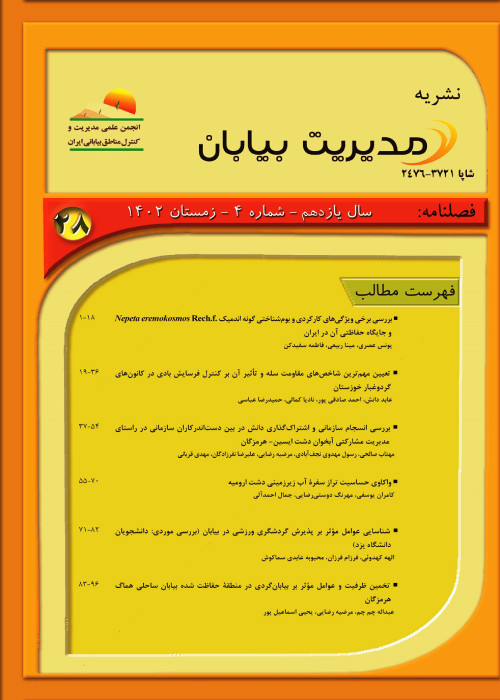Sensitivity Areas Assessment of Desertification Using ESAs Model and Prioritizing Management Strategies (Case study: Kavir-e- Namak Basin, Khorasan Razavi Province)
Desertification, as a complex process, is a serious threat to the environment in many parts of the world, especially in arid regions. With accurate knowledge of the factors influencing the spread of desertification and appropriate management strategies, the impacts of this process can be controlled or reduced. The aim of the current study was to identify and assess indicators and indices of desertification for the assessment and mapping of sensitive areas of the Kavir-e-Namak basin in Khorasan Razavi province, to desertification. In this study, an assessment model of sensitive areas to desertification (ESAs or MEDALUS), available data based on field studies in 2021, was used. At first, five criteria including soil, climate, vegetation, erosion and human activities were identified as the main criteria for desertification. Then, on the basis of the opinions of over 40 natural resource experts, the indices of each criterion were classified, weighted and assessed. The quality of each criterion was determined by the calculation of the geometric average of the indices. Finally, the map of areas sensitive to desertification in the study area was produced using GIS. The identification of management strategies was conducted using the Delphi approach and distributing a two-cycle questionnaire based on scenario planning and future studies. The results showed that among the criteria for desertification in the study area, climatic criteria, human activities, soil and erosion with values of 1.54, 1.53, 1.51 and 1.50, respectively, are the most important criteria followed by the vegetation criterion with a value of 1.45 as a next effective criterion of desertification. Results indicate that 12% of the study area are in the fragile class, and approximately 88% in the moderate to severe critical class. Based on scenario planning and method of futures studies, the best and worst scenarios in four different categories including adaptive management and organizational cohesion, economic and social empowerment of local communities, educational development, culture and advertising, and participatory implementation of natural resource projects as comprehensive management strategies were developed.
- حق عضویت دریافتی صرف حمایت از نشریات عضو و نگهداری، تکمیل و توسعه مگیران میشود.
- پرداخت حق اشتراک و دانلود مقالات اجازه بازنشر آن در سایر رسانههای چاپی و دیجیتال را به کاربر نمیدهد.




